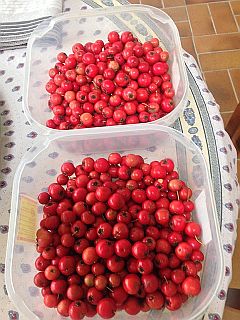» Home
» About
» Membership
» Journal
» Sparoza Garden
» Branches
» MGS Forum
» Seed Exchange
» Donations
» MGS Excursions
» Information
» Members' Gardens
» Book Reviews
» News & Views
» Contact
» Search
|
Edibles to grow in a mediterranean-climate garden:
Mediterranean hedgerow fruits
Azarole, Crataegus azarolus
by Jean Vaché
I am fortunate in having two mature trees of this Mediterranean member of the rose family growing nearby in the wild. When I was young, in the hills above Lunel, we used to look for the sweet-tart fruit which we called “pommettes”, for their resemblance to small apples. And there is also a young tree, perhaps a little over five years old, inside my garden, sown there by some magpie benefactress. It grows not far from a regular hawthorn of a nondescript variety. I recently decided to invite into the garden a cousin, Malus ‘Evereste’, a crab apple cultivar, for its lovely blossom and for the small picturesque apples that birds love to eat in winter.
In October or at the beginning of November in Languedoc the long maturing season of the berries is finished and the trees are covered with hundreds, sometimes thousands, of bright red fruit. It is no easy task to gather the berries for the branches are thorny. I use the following method: I spread a large piece of cloth on the ground around the tree and, using a long stick, I gently tap the branches, causing the reddest berries to fall like hail. Using a pail to collect them, and eliminating the leaves or twigs, I next give them a good wash. They are now ready to be cooked, but there is no rush; once dry and kept in a cool place, they can wait for several days.
Like most fruit-bearing trees in the garrigues, you cannot count on Crataegus azarolus to yield fruit every year; but for some unknown reason, 2015 was a bonanza year and I took the opportunity to prepare a few pots of the vividly coloured jelly.

Azarole fruit
Recipe: Red Azarole Jelly
I throw the berries into a large cooking pan, adding enough water to cover, and I simply boil them until tender, which generally takes less than 10 minutes. Using a sieve, I separate the fruit and liquid. If I am in a festive mood, I set the fruit aside for making a paste later, exactly as if I was making quince paste, “pâte de coing”, to eat with roquefort at Christmas dinner.
To return to my recipe, I must now measure exactly how much liquid is left after boiling, for that will dictate the amount of sugar to add to the jelly. The secret of this jelly is to make only 3 or 4 pots at a time. Jelly-making in the old days involved cooking the liquid until the setting point was reached which took a long time; meanwhile the lovely ruby colour of the liquid was lost. Nowadays, I use a natural jellying agent, agar-agar, made from red algae, which I buy in a vegetarian shop.
In the last batch I made, there were 750 grams of liquid left once the fruit had been removed, so using a ratio of liquid to sugar of 3:2, I mixed 500 grams of crystallized sugar into it and brought it to the boil which I maintained for a few minutes. I put the pan aside; then, in a ladleful of the red liquor I mixed 3 grammes of agar-agar (1 gm per 250 gm of liquid) which I then stirred into the liquid.
Pour the still hot fragrant liquid into your pots, allow them to cool off and place in the refrigerator for a night to help the jellying process.
You can use azarole jelly on buttered toast, to glaze an apple tart, or as a sauce for lamb. You can be inventive with it.
December 2015 |


